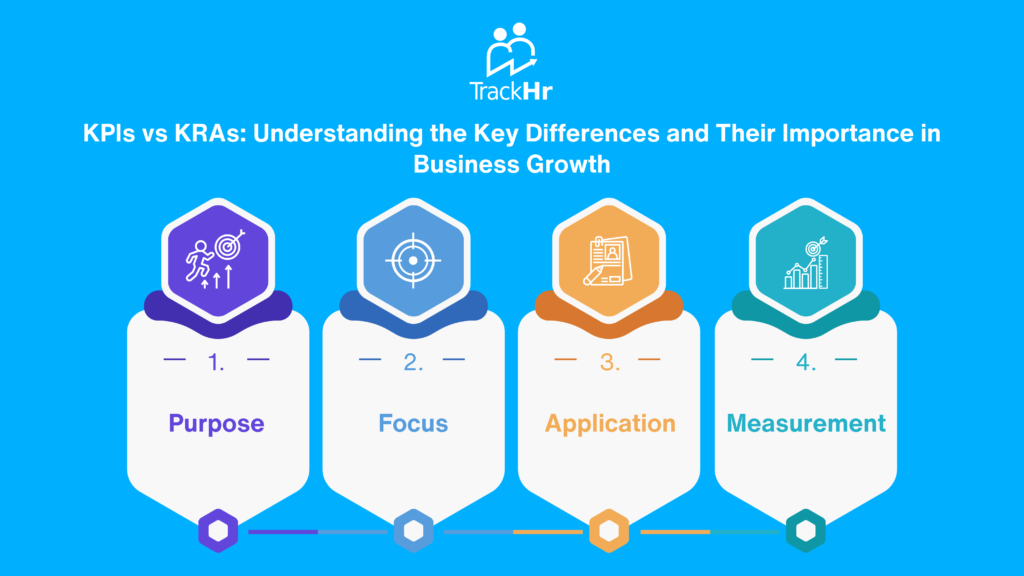Thursday, 25 July 2024
KPIs vs KRAs: Understanding the Key Differences and Their Importance in Business Growth
In the dynamic landscape of business management, two acronyms often emerge as central to measuring and driving performance: KPIs (Key Performance Indicators) and KRAs (Key Result Areas). While they are sometimes used interchangeably, they serve distinct purposes in the framework of organizational success. This blog will demystify KPIs and KRAs, highlighting their differences, importance, and how to effectively utilize them in your business.
What Are KPIs?
Key Performance Indicators (KPIs) are measurable values that demonstrate how effectively a company is achieving key business objectives. They provide a clear picture of performance and progress over time, enabling managers and stakeholders to make informed decisions. KPIs are quantifiable and are typically used to track the efficiency, performance, and success of various operations within a company.
Examples of KPIs:
- Sales Growth Rate
- Customer Acquisition Cost
- Employee Productivity
- Customer Satisfaction Score
- Net Profit Margin
What Are KRAs?
Key Result Areas (KRAs), on the other hand, are the critical areas of output for which an individual or team is responsible. KRAs define the scope of an employee’s role and the key responsibilities that must be fulfilled to achieve desired outcomes. They provide a clear understanding of what is expected from employees and how their work contributes to the overall objectives of the organization.
Examples of KRAs:
- Sales Performance for a Sales Executive
- Product Development for a Product Manager
- Client Relationship Management for a Customer Service Representative
- Financial Reporting Accuracy for an Accountant
Key Differences Between KPIs and KRAs

Purpose:
- KPIs measure performance and progress towards specific goals.
- KRAs define the main areas of responsibility and expected outcomes.
Focus:
- KPIs are focused on quantifiable metrics.
- KRAs are focused on key responsibilities and tasks.
Application:
- KPIs are used at various levels within an organization, from individual performance to overall business health.
- KRAs are more focused on individual roles and departmental outputs.
Measurement:
- KPIs are numerical and can be tracked through data and statistics.
- KRAs are more descriptive and qualitative, outlining the critical areas that need attention.
How to Effectively Use KPIs and KRAs
To maximize business growth, it is crucial to integrate both KPIs and KRAs into your performance management strategy. Here’s how:
Align KRAs with Business Objectives: Ensure that the KRAs for each role are aligned with the overall strategic goals of the organization. This alignment ensures that every employee’s efforts contribute directly to the business’s success.
Set SMART KPIs: KPIs should be Specific, Measurable, Achievable, Relevant, and Time-bound. SMART KPIs provide clear targets and timelines, making it easier to track progress and make necessary adjustments.
Regular Monitoring and Review: Regularly review KPIs and KRAs to ensure they remain relevant and aligned with changing business priorities. This process helps in identifying areas of improvement and making informed decisions.
Use Technology for Tracking: Implement performance management tools, such as TrackHr, to automate the tracking of KPIs and KRAs. These tools provide real-time insights and analytics, facilitating better decision-making and performance optimization.
Employee Engagement and Feedback: Engage employees in the process of setting and reviewing KPIs and KRAs. Encourage feedback and suggestions to foster a culture of continuous improvement and accountability.
Conclusion
Understanding the differences between KPIs and KRAs and effectively integrating them into your performance management strategy is crucial for driving business growth. While KPIs provide a quantitative measure of progress, KRAs define the qualitative aspects of an employee’s role and responsibilities. By aligning both with your business objectives, regularly reviewing them, and leveraging technology for tracking, you can enhance performance, productivity, and ultimately, achieve your organizational goals.
Embrace the power of KPIs and KRAs to unlock the full potential of your business in today’s ever-changing world.
